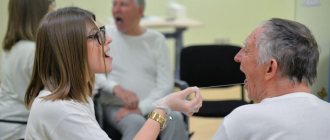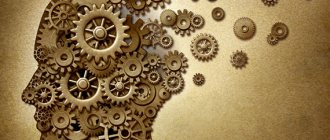The mental health of each person is a very delicate matter, the slightest fluctuations of which can lead to a number of negative consequences for the subsequent full-fledged social life.
In the modern world, according to statistics, every fifth resident of a large city is a carrier of a certain type of mental disorder. This is caused by an overactive rhythm of life, chronic fatigue and frequent stressful situations. The danger is that some people may not be aware of their illness for many years, attributing everything to fatigue and workload. And only at the moment when a failure occurs, it becomes clear that the reasons lie much deeper and it is necessary to look for them with a qualified specialist. Treatment of mental disorders. Symptoms and signs
Today, medicine knows many mental illnesses, which differ in different types of manifestation. However, there is one connecting link between all disorders - this is a combination of abnormal thoughts, emotions and behavioral reactions aimed at the patient himself or at people around him.
The most common mental health disorders are:
- depression;
- schizophrenia;
- panic attacks;
- eating disorders (anorexia, bulimia);
- mental retardation;
- autism;
- bipolar affective disorder;
- psychoses.
The specialized clinic “Salvation” provides a wide range of services and high-quality treatment for mental disorders. The symptoms and signs of each individual disease have their own character, which is why a competent approach and properly selected support guarantee significant improvements in health in the shortest possible time. Therefore, if you find that the behavior of your relatives has changed, they forget the names of objects, dates, faces, you should not self-medicate. Such signs indicate mental disorders and require the experienced eye of a specialist.
Symptoms of mental disorder
Each mental illness begins with the appearance of various symptoms, which, as a rule, one at a time do not raise any special questions from others and it can be difficult to collect them all into a single picture. However, careful observation of a person over several days will allow us to draw conclusions for taking further measures.
Symptoms of mental disorders in most cases are closely related to a person’s depressed state, which prevents him from performing daily routine activities. These symptoms include:
- physical (sleep disturbance, both in the direction of insomnia and vice versa, constant loss of strength even after proper rest; headache, etc.);
- behavioral (abuse of pills, cigarettes and other substances in large quantities, inability to perform work);
- cognitive (inability to think clearly, memory problems);
- perceptual (obsessive thoughts);
- emotional (constant feelings of anxiety and sadness).
The presence of several symptoms immediately indicates a problem and the need for professional consultation with a psychologist or psychotherapist. Identifying the causes and the possibility of making a diagnosis in the early stages will help quickly get a person out of such an undesirable state.
Causes of mental disorders
Some deviations in mental health can be caused by absolutely understandable reasons, for example, damage to a certain area or the entire area of the brain, traumatic brain injury, intoxication or problems with blood vessels. While depression, schizophrenia and a number of other diseases are not tied to a specific factor, and even with numerous studies, it has still not been possible to establish an unambiguous cause for the development of pathologies.
The causes of mental disorders are:
- internal (genetics; developmental disorders at a certain stage of pregnancy; developmental abnormalities at an early age; somatic diseases that affect the functioning of the brain; immunological disorders; hormonal imbalance, etc.);
- external (chronic stress; alcohol and drug intoxication; consequences of encephalitis or meningitis infections; traumatic brain injuries; exposure to radiation).
Most often, the causes of mental disorders are a combination of various factors when, for example, an organism weakened by infections finds itself in a highly stressful environment. The presence of each factor and its level of effect on a particular person must be assessed by an experienced specialist.
Most doctors approach mental health disorders as a multifactorial disease, since even if the main cause of the problem is known, related issues also play an important role and must be taken into account in the treatment process. These include:
- human living conditions;
- features of upbringing and traditions in the family;
- surrounding society;
- general health;
- work and family environment;
- originality.
PsyAndNeuro.ru
In demographic and health studies, the division of the “elderly” age group into subgroups is sometimes used. Typically, the boundaries of the subgroups look like this: “young old” – 60-74 years old, “old old” – 75-85 years old, “oldest old” – over 85 years old.
The prevalence of depression in the 85+ age group ranges from 5 to 32%. The risk is increased by living alone, medical illnesses, functional decline and cognitive impairment. In general, depression in this age group manifests itself in the same way as in other age groups. But there are some clinical features that are characteristic of the 85+ group, which include an increased likelihood of subthreshold symptoms, “depression without sadness,” concern about physical health, unexplained somatic symptoms and apathy.
Bipolar disorder is uncommon in older people. In the 65+ group, the prevalence is 0.1-0.5% (in young people 1.4%). Many cases are a relapse of an early illness, diagnosed bipolar disorder or recurrent depression, which for the first time in life gave way to mania. Pathological mood elevation, which first appears in old age, is associated with various medical, cardiovascular and cognitive factors. In general, the clinical manifestations of mania are the same at all ages, but in older adults, mania is less intense and symptoms are more likely to persist for a longer period of time. Symptoms of mania last for at least a week, causing significant functional impairment, and are sometimes so severe that psychosis (delusions of grandeur, paranoid delusions, and thought disorder) sets in. At least one episode of mania in a lifetime is enough to make a diagnosis of bipolar I disorder. With hypomania, symptoms may last less (4 days) and are usually less severe (without loss of function). Hypomania can occur in bipolar I disorder (if there was a history of mania), but if there was a history of major depressive disorder, a diagnosis of bipolar II disorder can be made.
The prevalence of anxiety disorders in the elderly is 15%, and certain symptoms are even more common. Anxiety disorders almost always begin at a younger age, relapses are followed by remission, the onset of symptoms is tied to life stress, and relapse in old age often occurs due to the fact that the usual coping strategies cease to work. Risk factors: female gender, absence of a spouse, multiple comorbid conditions (including vascular diseases), certain character traits (neuroticism and perfectionism). Only a minority develop anxiety disorders in old age. This may occur in the context of an adjustment disorder or in association with cognitive decline or physical illness. Particularly severe agitation and dysphoria may indicate anxiety secondary to depression, although depression and anxiety may coexist in the oldest old.
GAD is most common in older people. Comorbid mental disorders (especially depression), as well as the appearance of GAD against the background of certain somatic diseases (for example, stroke or Parkinson's disease), are very typical.
Phobias are also common. More often than in young people, specific phobias associated with the natural environment (lightning, heights) occur. Also common (60% in some samples) is phobia of falls, a condition that occurs after the experience of falling or due to problems with balance. Agoraphobia can develop as a result of fear of falling, awkward situations (for example due to incontinence), panic attacks in a public place.
Panic disorder, OCD, and PTSD are much less common and are usually associated with physical illness or cognitive decline. There are studies showing that older people with OCD are more likely than younger people to develop obsessions related to the idea of sin, compulsive hand washing, and pathological hoarding. Trauma in old age (falls, cancer risk, bereavement, frightening experiences of delirium) can cause anxiety similar to PTSD symptoms, and in addition, physical, cognitive and psychosocial stress can activate PTSD associated with youth trauma (including experiences in school and the military ).
Psychosis is quite common in the elderly. Usually these are secondary psychoses, but there are also primary ones. According to DSM-5, secondary psychotic syndromes in the elderly include delirium, dementia, and mood disorders. Primary psychotic syndromes include delusional disorder, schizophrenia, and schizoaffective disorder. Symptoms overlap regardless of the cause of psychosis, but often the outlines of the disease are obvious and indicate a likely etiology.
Primary psychotic illnesses with onset in youth progress differently and can continue into old age. Many years of use of antipsychotics or mood stabilizers result in extrapyramidal side effects, tardive dyskinesia, metabolic or renal dysfunction, and electrolyte imbalances.
Primary psychotic conditions can also occur in old age. This happens more often in women. More likely to occur in groups that are marginalized, discriminated against, or have difficulty communicating socially, such as migrants and people with hearing or vision impairments. From a clinical perspective, they may meet traditional diagnostic criteria for schizophrenia or delusional disorder, or fall somewhere “in between” these diagnoses. Such cases are referred to as paraphrenia, late (after 40 years of age) schizophrenia, or very late onset (after 60 years of age) schizophrenia-like psychosis, reflecting the lack of clear definitions, classification and phenomenology in studies of this very heterogeneous group of patients. Most experience delusions of persecution, often in the form of ideas about being observed or influenced through walls, floors, or ceilings, directly or through gas, radiation, or electricity. Auditory hallucinations are common. Formal thought disorder is rare, and the affective state usually does not change. Mild cognitive deficits may occur.
Men commit suicide much more often, with age peaks occurring in middle age and at age 85+. An important risk factor is depression, especially with comorbid anxiety, and in a large number of cases depression remains undiagnosed until a suicide attempt.
(The author of the article refers to Australian statistics from 2015 showing an increase in the likelihood of suicide in men in the age groups 45-49 and 85+. The age profile of suicide mortality in Russia (2010-2014) is slightly different: for men the peaks are at 30 -34 and 80+, for women 85+.)
The likelihood of suicide increases with the presence of somatic diseases (especially cancer and cardiovascular diseases), disability, social isolation and personality traits such as introversion, anxiety, and obsession. Most often, the reasons are traumatic losses, loneliness, extremely severe anxiety, loss of independence, and a feeling of hopelessness.
Key Points in a Psychiatric Examination
- It is necessary to collect information from close people (relatives, friends, social workers), especially if there is cognitive impairment that makes it difficult to describe symptoms. In addition to facilitating diagnosis, it provides valuable data about the patient's premorbid personality, functionality, and the nature of his social relationships.
- It is necessary to assess risks of all types:
– Risk to the patient (self-harm, accident, self-neglect);
– Risk to reputation and financial well-being;
– Risk from others (ignoring the patient’s needs or intentionally causing harm);
– Risk to other people (aggressive behavior or disregard for the safety of others);
The nature and severity of these risks will determine the choice of treatment strategy.
- It is necessary to find out whether the observed condition is the debut of a mental illness or is it a relapse of a recurrent disease. It is necessary to understand the risk factors and possible causes (family history, cardiovascular factors, relevant medical diseases, use of drugs that affect the mental state).
- It is important to remember that in this age group, depression and anxiety often manifest subsyndromal or somatic forms.
- You should always ask about substance use. It's easy to miss important things like alcohol or drug abuse (especially benzodiazepines and opiates) and excessive caffeine consumption.
- Cognitive abilities should always be assessed.
For some types of disorders, non-pharmacological treatment may be sufficient. The best studied method is cognitive behavioral therapy. There is ample evidence of its effectiveness for insomnia, chronic pain, substance abuse, depression, delusional disorders, hallucinations and some types of psychosis, and especially anxiety disorders - but there is insufficient evidence of effectiveness in the 85+ age group.
The medications and neurostimulation methods used are generally no different from those used in other age groups. Despite the risk of side effects, antidepressants, antipsychotics and sedatives are prescribed particularly frequently in the “oldest elderly” group. As with all age groups, the first step should be to obtain informed consent from the patient.
The choice of antidepressant is influenced by its tolerability. There are studies showing that the effectiveness of antidepressants is reduced in depression that begins in old age against the background of vascular pathologies and dementia.
SSRIs are the first-line drugs of choice. Alternative antidepressants include SSRIs (especially in cases of severe depression or in the presence of comorbid neuropathic pain), tetracyclic antidepressants, agomelatine or SNRIs.
The first signs of improvement appear after a couple of weeks, but the therapeutic effect in the elderly sometimes has to wait longer than usual (10-12 weeks); It is important not to change treatment ahead of time, but to continue the course. If the drug is poorly tolerated or has no effect, you can change the dose or switch to a different class of antidepressant. You can then consider switching to second or third line antidepressants, as well as augmentation with another type of drug (lithium, atypical antipsychotic, thyroxine).
ECT has a good antidepressant effect with a remission rate of 60-90%. If the patient tolerates general anesthesia and the cardiovascular effects of ECT (abrupt changes in heart rate and blood pressure), and has no contraindications (recent heart attack or stroke, increased intracranial pressure or mass formations in the skull, retinal detachment), then ECT can be safely used in the 85+ group. Side effects are usually minor (headache, nausea), the main potential problem is related to cognitive impairment (confusion, anterograde and retrograde amnesia, deterioration of executive functions); In most cases, this resolves over time, but in some patients, cognitive problems may persist for a long time.
For mania, any mood-elevating drug should be discontinued and replaced with a mood stabilizer.
First-line drugs for anxiety are SSRIs and SSRIs. Patients with anxiety are often wary of their physical health and may mistake anxiety symptoms for medication side effects; in such cases, an explanation of the situation is required in order to avoid premature discontinuation of the drug and unnecessary repetition of the course. Sometimes a low dose anxiolytic (such drugs may include atypical antipsychotics and pregabalin) is added to control symptoms before the antidepressant takes effect. Benzodiazepines should be avoided if possible or used in low doses only for short periods of time.
The use of antipsychotics in the treatment of elderly patients is associated with a high risk of side effects. As always, this risk must be weighed against the risk of untreated symptoms by assessing the likelihood that antipsychotics will improve the patient's condition. In dementia, one should always focus on non-pharmacological interventions first, reserving antipsychotics for the most persistent psychotic symptoms associated with distress and behavior problems. Late-onset schizophrenia responds to treatment at doses lower than those used for early-onset schizophrenia.
The use of atypical antipsychotics is preferable because their side effects are better tolerated. However, they also have side effects. In some groups (patients with dementia), the risk of death (especially due to pneumonia and heart problems) and the development of physical diseases (including cardiovascular disease) is increased. Apart from clozapine, which is rarely prescribed to the elderly, quetiapine has the lowest likelihood of extrapyramidal side effects. Aripiprazole has fewer metabolic side effects and risperidone has fewer anticholinergic effects. Oral administration is preferred, but in case of poor compliance, injections can be used.
– Mental illness in the elderly may be a relapse of an illness that began long ago, or it may be the debut of a late-onset condition.
– Very often in the “oldest elderly” group, the basis of psychological problems is somatic diseases.
– Depression in the elderly often manifests subsyndromal or in the form of somatic symptoms.
– Treatment is the same as in other age groups, but should start with low doses, increasing slowly if necessary.
– Antidepressants and antipsychotics have significant side effects, but the benefits of taking them may outweigh the risk of side effects.
– ECT is an effective treatment for melancholic or psychotic depression and can be safely used in the treatment of elderly patients.
– For dementia, we need to start with non-pharmacological treatment strategies.
– Older men are at high risk of suicide, so assessing suicide risk is an important part of the assessment.
Author of the translation: Filippov D.S.
Source: Cullen P. (2019) Mental Illness in the Oldest-Old. In: Nagaratnam N, Nagaratnam K, Cheuk G (eds) Advanced Age Geriatric Care. Springer, Cham
Signs of mental disorder
The peculiarity of mental illness is that there are no conditions, ages, nationalities or races for them. Absolutely every person, especially in the current world of multitasking and constant stress, is susceptible to threat. You can recognize the signs of a mental disorder with some careful observation of the behavior of others and your own.
- No matter how crazy you go. Everyone has fear - of newness, forgetfulness, a pressing deadline, natural disasters and other similar things. Constant thoughts around what a person is afraid of, together with a series of nervous situations at home or at work, can cause neurosis and panic attacks. And when mental health is shaky, psychosomatics can also get involved. In such a set it is difficult to find the root cause, and the neglected process can result in a more serious mental illness.
- Absent-mindedness. Conditions of constantly tight deadlines have a strong impact on the nervous system. It’s simply physically impossible to do everything, and you become distracted and forgetful. The nervous system cannot cope with overstrain and fails. As a result, the development of a mental disorder.
- Not good enough. Beauty standards, fashion canons, and high standards lead to the emergence of a whole complex of mental illnesses. This includes depression, eating disorders and psychosis. N
- Addiction. In addition to addiction to various alcoholic and psychotropic substances, which cause many mental disorders, psychologists have found that workaholism can also lead to unwanted diseases. Constant immersion in work matters, sleep disturbances and emotional burnout are slowly and surely preparing another person who needs the help of a psychotherapist.
Mental health promotion and prevention
Mental health promotion and prevention measures are designed to strengthen a person’s ability to control their emotions, expand the range of alternatives to risky behaviors, develop resilience to successfully cope with difficult situations or adverse factors, and promote the formation of a favorable social environment and system of social relationships.
These programs must be delivered at multiple levels, using a variety of platforms, such as electronic media, health and social care settings, school-based or community settings, and a variety of strategies to ensure they reach adolescents, especially those in the most vulnerable groups. population.
People with mental disorders
As already mentioned, every person is susceptible to mental illness to varying degrees. Unfortunately, a healthy lifestyle and careful treatment of the nervous system cannot always guarantee the effect of “vaccination” against such diseases. People with mental disorders are not always the ones you often see in films. Not everyone wears white straitjackets, hears voices and sees things that others don't. Most people suffering from mental disorders are ordinary passersby whom you can meet on the way to work, neighbors at the nearest table in a coffee shop, and even friends and family. However, there are also more serious forms of the disease.
Mental disorders in adults
Most mental health problems in adults arise and develop against the general background of dissatisfaction with life, as well as particular stressful situations that can be accompanied both in the family and at work.
Bipolar disorder has gained widespread popularity because the number of patients it reaches is frightening. The disease manifests itself through frequent uneven mood swings, when a person, from vigorous activity, is transferred to a period of complete powerlessness, with the inability to eat, move and continue a full life.
Another most common mental disorder in adults is depression. Despite the fact that psychologists have long been trumpeting the danger of this disease, modern society still does not pay due attention to it and subsequently specialists have to treat more advanced forms that the person himself is not able to cope with.
Schizophrenia. May arise from dissociative identity disorder or as a separate disorder. As a rule, the disease develops against a background of disharmony and a tense nervous state over a long period of time, but schizophrenia can also develop on a completely stable neurological basis.
Women, as a separate category, are more susceptible to mental disorders than men. The most common diseases include manic-depressive psychosis, eating and sexual behavior disorders, delirium and alcohol addiction, nervousness and panic attacks.
Adolescent psychosis: features of manifestations
The symptoms of the disorder in adolescence are very diverse. It concerns emotional disturbances, thinking disorders, and behavioral problems. Parents and adults close to the patient need to know the main deviations that occur with this pathology.
Symptoms of a psychotic state:
- Hallucinations are visions of non-existent phenomena and objects. Relatives should suspect the presence of hallucinatory experiences in their children by suddenly freezing and listening, talking to something (someone) invisible, causeless laughter, or fear.
Rave. This symptom is characterized by the emotional expression of inadequate ideas and conclusions that do not correspond to reality. The patient is firmly convinced that he is right. He is not amenable to logical persuasion. His statements contain a fantastic nature, often accompanied by fear and defensive actions (running, closing windows, curtains). Delirium can be of a very diverse nature.- Depressive disorder. In this case, teenagers withdraw to the point of stupor, are alone for a long time, are pessimistic, do not sleep at night, eat poorly, or, conversely, constantly experience uncontrollable hunger. Against the backdrop of mental torment, they can harm themselves.
- Manic. Young patients are characterized by excessive and unproductive activity, make many unrealistic plans, and live in a state of overestimating their capabilities. They are verbose, emotional, and grimace. Despite the lack of desire for sleep, they feel alert.
Mental disorders in children
As every child goes through certain stages of his life, he faces a lot of problems and challenges. Some people endure all the difficult periods, but there are also those who are not ready for such conditions. Mental disorders in children can begin under the pressure of various factors.
- The formation process is often accompanied by the child’s rejection of himself and his own body. This causes various behavioral reactions, such as overeating or, conversely, refusing to eat. This eating disorder can lead to anorexia or bulimia.
- Peer bullying. Once one person stands out, he becomes a target for others. School bullying causes nervousness, psychosis, and depression. Suicidal thoughts may appear.
- Tense situation in the family. A very common cause of mental disorders in children is an unhealthy environment. If constant violence occurs in front of a child, then a mental disorder is guaranteed and can subsequently cause the development of schizophrenia. In an attempt to escape from reality, children invent a different life for themselves and stop this process, especially in an advanced stage. It can be extremely difficult.
- Congenital mental disorders of children can be caused by genetic predisposition, as well as unacceptable behavior of parents at the time of bearing the baby.
Due to age and mental characteristics, the list of mental disorders in adolescents includes:
- Hypochondria
is an obsessive search and fear of finding a dangerous disease or contracting a serious, incurable somatic disease; - Depression
is a disorder that manifests itself in the predominance of a negative outlook on life, decreased mood, and loss of the ability to experience joyful emotions. - Body dysmorphomania
is a pathological belief in the presence of a serious physical defect; - Anorexia nervosa
is a painful, pathological desire for food restriction and weight loss; - Derealization
is a violation of perception, when a teenager feels that the environment has changed and has become “unnatural”; in severe cases, he goes into a fictional world or considers the real world to be such; - Depersonalization
is a disturbance in the perception of one’s own “I” or one’s body, a condition in which a teenager perceives himself as if from the outside, and is unable to control his actions; - Deviant behavior
is behavior that deviates from generally accepted norms in society; - Socialized behavior disorder
is aggressive, defiant, provocative behavior that differs sharply from social norms accepted in society; - Neurosis
is a set of neuropsychic disorders caused by persistent one or more mental traumas; - Schizophrenia
is a disorder characterized by severe disturbances in perception, thinking, and emotional response.
If you do not know how to recognize mental disorders in a teenager, then there is a whole list of symptoms that will help you indicate a possible problem. It is necessary to carefully monitor the teenager and if there are several severe symptoms, do not delay contacting a doctor. Here is just a small approximate list of manifestations of mental disorders in adolescents that may alert you: prolonged melancholy (more than 2-3 weeks), cruelty, irritability, aggressiveness, attacks of fear and panic, attempts at self-harm or suicide, refusal to eat, neglect of one’s appearance, sloppiness, constant mood swings, deterioration of memory, perception, attention, etc.
To ignore these symptoms means to accept the risk of developing such serious mental disorders as schizophrenia, epilepsy, mental retardation (MDD), etc. Diagnosis and treatment of psychoses and disorders in adolescents is a task for qualified specialists. The Ross Clinic in Moscow employs child psychiatrists who have experience in successfully treating diseases of varying degrees of complexity in children and adolescents.
Levels of mental impairment
When diagnosing mental health diseases, doctors identify levels of mental disorder, depending on which decisions are made on further treatment and stabilization.
The first level is neurotic, which represents the appearance of various phobias, fears and neuroses, which can be caused by illness or some external factors. Divided into several types:
- neurasthenia (this implies nervous exhaustion of the body, weakness, apathy and irritability);
- obsessive-compulsive disorder (accompanied by an obsessive state when a person thinks that he hears or sees something that is not actually there);
- hysterical neurosis (refers to conditionally desirable types of disorder and begins when a person may benefit from it, although he himself may not be aware of such a reaction of the body).
The first level of violations is characterized by the beginning and end of the process in approximately limited periods. Such disorders most often affect people who have such a predisposition. However, various mental traumas can also trigger neurosis.
The second level is called psychopathic and is a reflection of all human personality disorders. These are certain nuances in behavior, as well as character traits that are present with a person throughout his life.
And the last level of disorders is psychosis (psychotic). This stage of the disease is accompanied by the appearance of hallucinations and delusions. Various manias, catatonia and mental confusion may also occur.
Teenage psychosis: causes
There are a lot of factors that cause pathology.
Doctors at our health center most often identify the following:
- Heredity. Parents often pass on genes that predispose them to the disease to their children.
- Trauma, brain intoxication, acute and chronic poisoning with psychoactive substances.
- Epilepsy.
- Oncological processes in the central nervous system.
- Diseases of internal organs and endocrine system: bronchial asthma, connective tissue diseases (rheumatism, lupus, scleroderma), thyroid pathology.
- Vitamin deficiencies, electrolyte metabolism disorders.
- Malfunctions of the hormonal system.
- Psychotrauma.
- Mental illnesses: epilepsy, schizophrenia, bipolar disorder and others.
- Alcohol and drug addiction.
Treatment of mental disorders
Depending on what disorder the patient suffers from, completely different treatment methods may be needed. In addition, it is worth considering that the treatment of mental disorders in each individual case is deeply individual and requires a careful approach.
The early stages of most diseases are not accompanied by severe problems, so doctors do not recommend placement in clinics and the use of aggressive therapy. If a person is independently able to recognize the presence of a problem, then the treatment process is based on consultations with a psychologist and psychotherapist and work to identify the causes that gave rise to the disease.
Diagnosing mental disorders in a mild form allows you to get by with “little blood” and build recovery in such a way that the patient will recover in a short time and can easily restore his mental health.
Treatment of mental disorders in adults
Mental disorders for different age categories differ in many ways, so the right approach to recovery is also selected taking into account the differences. For example, treatment of mental disorders in adults is often accompanied by the use of a group of antidepressant drugs, which is completely unacceptable when treating children.
Each disorder, be it autism or initial neurosis, requires its own techniques.
- Depression. Treatment methods should be selected based on the severity of the disease. Depression in the early stages can be cured using traditional methods, as well as through the processes of socialization, the introduction of an active lifestyle and periodic visits to a psychologist. If we talk about advanced cases, treatment includes constant observation by a psychotherapist, in-depth study of the causes of occurrence with a psychologist, hypnosis and drug intervention.
- In the first stages of development, doctors suggest treating bipolar disorder by restoring sleep patterns and giving up all substances that have a psychotropic effect on the human body (alcohol, drugs, tobacco). There are also effective medications that help prevent relapses. They are designed to stabilize the mood, protecting a person from depressing thoughts. Psychosocial support plays an important role in the treatment of bipolar affective disorder.
- Dementia is one of those types of mental illnesses that cannot be completely cured. Today, there are a large number of medications that are only undergoing clinical trials. Treatment methods for this disorder come down to an integrated approach and careful care of the person.
- Schizophrenia and neuroses in modern medicine can also be treated with medications, regular visits to psychologists and human socialization programs. Thanks to the correct management of the healing process, people suffering from this type of disorder can lead a full, happy life.
How are adolescent psychoses treated?
Our clinic uses a comprehensive approach to treat mental disorders.
After medical diagnosis, the attending physician selects and forms a therapeutic plan. It includes drug therapy and the use of psychotherapeutic methods.
Drug treatment includes prescription:
- Antipsychotics that suppress hallucinations, delusions, and affective states.
- Sedatives. With their help, excessive emotionality is removed and psychotic fears are eliminated.
- Antidepressants. These medications are necessary for patients with depression, suicidal thoughts and behavior.
- Normotimics. These remedies prevent manic outbursts and allow you to independently establish control over your emotions.
- Anticholinergics. Required for patients with manifestations of adverse reactions while taking antipsychotics.
Psychotropic pharmacotherapy is allowed only in clinical settings. Caution is caused by the strong effect of drugs in this group. Patients taking specific pharmacotherapy require constant monitoring.
Our psychotherapists solve the following problems for the treatment of adolescent psychosis:
- The need to enhance the effect of medications.
- Identifying and eliminating the cause of the psychotic state.
- Alleviation of existing symptoms.
- Relapse prevention.
- Teaching self-control skills in all situations.
Psychotherapy is prescribed only after the acute symptoms of psychosis have been relieved with medication.
Treatment of mental disorders in children
Most mental disorders in children are caused by adolescence and the stage of personality development. If symptoms indicating the development of deviations are detected, it is necessary to stabilize the atmosphere in the family as much as possible, spend more time with the child, talk about topics that concern him and support him in the first uncertain steps without criticism and intimidation. A visit to a psychologist and obtaining an expert point of view will also not be superfluous and will help you correctly plan the process of dealing with an unwanted illness.
Some diseases, such as schizophrenia, which appear already in adolescence, require mandatory drug intervention. However, many other disorders do not require the addition of medications to the treatment of mental disorders in children, therefore, the creation of harmonious relationships with oneself and society should be taken into the hands of parents or psychological professionals.
Early detection and treatment
Responding to the needs of adolescents with identified mental health problems is critical. The basic principles of working with adolescents are to avoid institutionalization, prioritize the use of non-pharmacological approaches and ensure that children's rights are respected in accordance with the United Nations Convention on the Rights of the Child and other human rights instruments. The WHO Mental Health Gap Action Program (mhGAP) provides evidence-based guidance for lay professionals to better identify serious mental health disorders and provide care in low-resource settings.
Organic mental disorders
Mental illnesses that occur when a particular area or entire area of the brain is damaged, due to various factors, are called organic mental disorders. This type of disorder includes multiple diseases that can occur due to external influences on the brain (traumatic brain injury) or internal processes (dysfunction). The main syndrome of organic disorders is damage to short-term memory. In such cases, a person remembers only those events, emotions and information that just happened. When repeated attempts are made to remember what happened, even after a few minutes, complete amnesia sets in. Often people “remember” certain moments in their lives, but when checked, this information turns out to be fictitious. The process of treating organic mental disorders includes an integrated approach, which involves medications, work with relatives and caregivers, as well as psychotherapy and psychopharmacotherapy.
Suicide and self-harm
Self-harm is estimated to be the cause of death in 62,000 adolescents in 2021. Suicide is the third leading cause of death among older adolescents (15–19 years old). Almost 90% of the world's adolescents live in low- or middle-income countries, and more than 90% of teen suicides occur among adolescents living in these countries. Risk factors for suicide are varied and include harmful use of alcohol, childhood abuse, help-seeking stigma, barriers to help, and access to means of suicide. This age group is associated with growing concern about the dissemination of information about suicidal behavior through electronic media.








